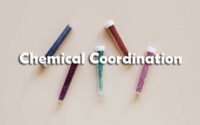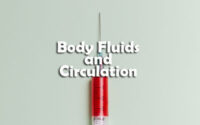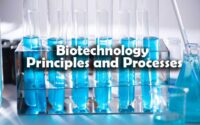Breathing and Respiration Questions and Answers
1. Lungs are made up of air-filled sacs, the alveoli. They do not collapse even after forceful expiration, because of—
A. Residual Volume
B. Inspiratory Reserve Volume
C. Tidal Volume
D. Expiratory Reserve Volume
2. Lungs do not collapse between breaths and some air always remains in the lungs which can never be expelled because-
A. there is a negative pressure in the lungs.
B. there is a negative intrapleural pressure pulling at the lung walls.
C. there is a positive intrapleural pressure.
D. pressure in the lungs is higher than the atmospheric pressure.
3. The partial pressure of oxygen in the alveoli of the lungs is—
A. equal to that in the blood
B. more than that in the blood
C. less than that in the blood
D. less than that of carbon dioxide.
4. Reduction in pH of blood will—
A. decrease the affinity of haemoglobin with oxygen
B. release bicarbonate ions by the liver
C. reduce the rate of heart beat
D. reduce the blood supply to the brain.
5. Asthma may be attributed to—
A. inflammation of the trachea
B. accumulation of fluid in the lungs
C. bacterial infection of the lungs
D. allergic reaction of the mast cells in the lungs.
6. Name the chronic respiratory disorder caused mainly by cigarette smoking—
A. respiratory acidosis
B. Respiratory alkalosis
C. Emphysema
D. Asthma
7. The volume of ‘anatomical dead space‘ air is normally-
A. 230 mL
B. 210 mL
C. 190 mL
D. 150 mL
8. Hiccups can be best described as—
A. forceful sudden expiration
B. forceful contraction of intercostal muscles during deep breathing
C. vibration of the soft palate during breathing while sleeping
D. jerky incomplete inspiration
9. Name the pulmonary disease in which alveolar surface area involved in gas exchange is drastically reduced due to damage in the alveolar walls—
A. Pneumonia
B. Asthma
C. Pleurisy
D. Emphysema
10. Which of the following is the most appropriate in normal circumstances?
A. During inspiration, the intrapulmonary pressure is less than the atmospheric pressure
B. During expiration, the intrapulmonary pressure is less than the atmospheric pressure.
C. During inspiration, the intrapulmonary pressure is more than the atmospheric pressure.
D. During expiration, the intrapulmonary pressure is equal to the atmospheric pressure
11. Partial pressures of oxygen and carbon dioxide in healthy human lung alveoli are, respectively, nearest to-
A. 104 and 40 mm Hg
B. 90 and 20 mm Hg
C. 40 and 45 mm Hg
D. 159 and 0.3 mm Hg
12. Which of the following sets of conditions promotes the dissociation of oxygen from haemoglobin?
A. Low po2, high po2, high H+
B. High po2, high pco2, low H+
C. High po2, low pco2, low H+
D. Low po2, low pco2, low H+
13. The volume of air that will remain in the lungs after a normal expiration is called—
A. vital capacity
B. functional residual capacity
C. residual volume
D. total lung capacity
14. The entry of food into the larynx is prevented by mitral valve diaphragm –
A. Mitral valve
B. Residual volume
C. Epiglottis
D. hyoid
15. Amount of air in the lungs that remains after deep breathing is called-
A. dead space
B. residual volume
C. vital capacity
D. ventilation rate
16. Bowman’s glands are found in—
A. olfactory epithelium
B. external auditory canal
C. cortical nephrons only
D. juxtamedullary nephrons
17. Approximately seventy percent of carbon dioxide absorbed by the blood will be transported to the lungs-
A. as bicarbonate ions
B. in the form of dissolved gas molecules
C. by binding to R. B. C.
D. as carbamino-haemoglobin.
18. The serous membrane which covers the lungs is called-
A. pericardium
B. peritoneum
C. perichondrium
D. pleura
19. The volume of air that can be breathed in by maximum forced inspiration over and above the normal inspiration is called-
A. expiratory reserved volume
B. inspiratory reserved volume
C. vital capacity
D. inspiratory capacity
20. The trachea terminates into—
A. bronchial tree
B. atrium
C. bronchi
D. alveoli
21. When percentage saturation of haemoglobin with O2 is plotted against p02, the obtained is—
A. J shaped
B. Hyperbola
C. sigmoid
D. U shaped
22. What is the p02 and pC02 in the systemic arteries?
A. po2 4O mm Hg; pco2 45 mm Hg
B. po2 95 mm Hg; pco2 104 mm Hg
C. po2 95 mm Hg; pco2 40 mm Hg
D. po2 104 mm Hg; pco2 159 mm Hg
23. To generate pressure gradients to facilitate expiration and inspiration, the human body uses the intercostal muscles and—
A. alveolar sacs
B. bronchi
C. primary, secondary and tertiary bronchioles
D. diaphragm
24. Choose the wrong statement-
A. Solubility of col in blood is 20 – 25 times higher than that of O2.
B. The total volume of air accommodated in the lungs at the end of a forced inspiration is called the ‘vital capacity‘.
C. O2 can bind with haemoglobin in a reversible manner to form oxyhaemoglobin.
D. Every 100 mL of de-oxygeneted blood delivers approximately 4 mL of CO2 to the alveoli.
25. Tidal air in mammalian lungs is—
A. air that normally goes in and out of lungs during breathing
B. total maximum air that can be drawn into lungs
C. air that is left in the lungs after normal expiration
D. air that can be expelled out from lungs forcibly after normal expiration.
26. The inspiratory reserve volume + tidal volume + expiratory reserve volume is the same as—
A. inspiratory capacity + expiratory reserve volume
B. total lung capacity — functional residual capacity
C. inspiratory capacity + functional residual capacity
D. inspiratory capacity + residual volume
27. Blood carries CO2 mainly in which form?
A. HbCO2
B. Carbonic acid
C. NaHCO3
D. HbCO2 and carbon monoxide
28. During the transportation of gases, to maintain the ionic balance, chloride ions shift from-
A. RBCs to plasma
B. plasma to RBCs
C. lungs to blood
D. blood to lungs
29. Oxygen binding to haemoglobin is—
A. directly proportional to C02 concentration
B. directly proportional to CO concentration
C. inversely proportional to CO2 concentration
D. independent of C0 concentration
30. People migrated from planes to hills six months back—
A. possess more RBCs with haemoglobin of low O2 binding affinity
B. possess same RBCs with haemoglobin of high O2 binding affinity
C. lose physical fitness to play games like football
D. suffer from altitude sickness with nausea and fatigue
31. After forceful inspiration, the amount of air that can be breathed out with maximum forced expiration is equal to—
A. TV + RV + ERV
B. IRV + TV + ERV
C. IRV + RV + ERV
D. lRV + ERV +TV+ RV
32. Which one of the following is the correct statement for respiration in humans?
A. Cigarette smoking may lead to inflammation of bronchi.
B. Neural signals from pneumotoxic centre in pons region of brain can increase the duration of inspiration.
C. Workers in grinding and stone—breaking industries may suffer, from lung fibrosis.
D. About 90% of carbon dioxide (CO2) is carried by haemoglobin as carbaminohaemoglobin.
33. The two organisms which breathe only through their mist skin are—
A. Frog and Earthworm
B. Fish and Frog
C. Fish and Earthworm
D. Leech and earthworm
34. Surfactant is—
A. protein produced by type II alveolar cells
B. excessive in many premature infants causing difficulty in breathing
C. decreases surface tension of fluid lining alveoli
D. lacking in individuals suffers acute respiratory distress syndromes
35. Volume of air which remains in conducting airways and is not available for gas exchange is—
A. vital capacity
B. anatomic dead space
C. functional residual capacity
D. forced expiratory volume
36. Following are few characters of a disorder in human body.
(A) Inflammation of the mucous membrane of nasal passage.
(B) Watery secretions by mucous glands
(C) Continuous sneezing
(D) Eye watering
(E) Rise in body temperature
Identify the disorder from the choices given below—
A. Bronchial asthma
B. Rhinitis
C. Bronchial carcinoma
D. Emphysema
37. Increase in body temperature makes oxygen haemoglobin dissociation curve-
A. shift to left
B. shift to right
C. hyperbolic
D. parabolic
38. Vital capacity of lung is equal to—
A. IRV + ERV + TV
B. IRV+ERV+TV- RV
C. IRV+ ERV+TV- RV
D. IRV + ERV
39. Amount of oxygen supplied by 100 mL arterial blood while passing through the tissues is—
A. 0.4-0.6 mL
B. 4-6 mL
C. 14-15 mL
D. 19-20 mL
40. Choose the right sequential phenomena among the following during the delivery of O2 from blood to tissue.
P : Absorption of CO2 by the blood.
Q : Reaction of absorbed CO2 with H2O to form H2CO3 within RBC and its conversion into H+ and HCO3 ions.
R : Reaction of absorbed CO2 with H2O in plasma to form H2CO3 and its conversion into H+ and HCO3 ions.
S : Combination of H+ with heme portion of HbO2 to release O2
T: Combination of HCO; with heme portion HbO2 to form reduced haemoglobin and release of O2.
A. P, Q, T
B. P, R, S
C. P, Q, S
D. P, R, T
41. The amount of O2 transported in a dissolved state through plasma is approximately—
A. 97%
B. 20 – 25%
C. 7%
D. 3%
42. The enzyme essential for the transport of CO2 as bicarbonate in blood is—
A. Carboxypeptidase
B. succinic dehydrogenase
C. carbonic anhydrase
D. thrombokinase
43. Expiratory capacity is—
A. Tidal volume
B. Residual volume
C. ERV
D. TV + ERV
44. Hypoxia corresponds to—
A. any change in the relative rates of development of different cell lines in body
B. hardening and loss of elasticity of arteries
C. deficiency of oxygen in body tissues
D. sudden interruption of blood flow to a portion of brain due to blockage of cerebral blood vessel.
45. Bulk carbon dioxide (CO2) released from body tissues into the blood is present as-
A. bicarbonate in blood plasma and RBCs
B. free CO2 in blood plasma
C. 70% carbamino-haemoglobin and 30% as bicarbonate
D. carbamino — haemoglobin in RBCs
46. A large proportion of oxygen is left unused in the human blood even after uptake by the body tissue. This oxygen—
A. is enough to keep oxyhaemoglobin saturation at 96%
B. helps in releasing more oxygen to epithelial tissues
C. acts as reserve during muscular exercise
D. raise pCo2 of blood to 75 mmHg
47. With conscious efforts one can—
A. breathe out air totally without oxygen breathe in and out by moving diaphragm alone without moving ribs at all
B. breathe out air through eustachian tube by closing both nose and mouth
C. empty the lungs completely by breathing out
D. all air out of them
48. Which one of the following can bind several hundred times more strongly to the haemoglobin than oxygen?
A. CO
B. Co2
C. So2
D. H2Co3
49. Pneumotaxic centre which can moderate the functions of the respiratory rhythm centre is present at—
A. pons region of brain
B. thalamus
C. spinal cord
D. right cerebral hemisphere
E. left cerebral hemisphere
50. At high altitude, RBCs of human blood will—
A. increase in number
B. Decrease in number
C. Decrease in size
D. Increase in size
51. In human beings the number of lobes in right and left lungs is—
A. 2 and 3
B. 2 and 2
C. 3 and 2
D. 4 and 2
52. Amount of CO2 in expired air is about-
A. 0.04%
B. 0.03%
C. 4.5%
D. 21%
53. Emphysema is a—
A. cardiovascular disease
B. pulmonary disease
C. renal disease
D. neural disease
54. High percentage of CO2 and very low percentage of O2 may make a person unconscious due to—
A. Eupnoea
B. Emphysema
C. Suffocation
D. Asphyxia
55. Chemosensitive area of respiratory centre in medulla is affected by—
A. less CO2 and H+ ions
B. less O2 and H+ ions
C. excess CO2 and H+ ions
D. excess O2 and H+ ions
56. What is true about RBCs in human-
A. They transport 99.5% of O2
B. They transport 80% oxygen, the rest 20% being transported by plasma
C. They do not carry CO2 at all
D. They carry 20 – 25% of CO2
57. In which of the following subjects, the dead space is highest-
A. Old man
B. Old woman
C. Young woman
D. Young man
58. Maximum amount 70 – 75% of carbon dioxide transport occurs as-
A. dissolved in plasma
B. carbaminohaemoglobin complex
C. bicarbonate
D. none of the above
59. Between breaths the interpleural pressure is approximately _________ mmHg less than atmospheric pressure-
A. 1
B. 4
C. 8
D. 10
60. Partial pressure of oxygen in alveolar air is—
A. 45 mmHg
B. 125 mmHg
C. 100 mmHg
D. 104 mmHg
61. In the resting person, saturation of haemoglobin as blood leaves the tissue capillaries is approximately—-
A. 75%
B. 40%
C. 3%
D. 46%
62. The respiratory rhythm centre is present in the—
A. Cerebrum
B. Cerebellum
C. hypothalamus
D. medulla oblongata
63. Pick the correct statement—
A. Contraction of internal intercostal muscles lifts up the ribs and sternum
B. RBC’s transport oxygen only
C. Thoracic cavity is anatomically an air tight chamber
D. Healthy man inspire approximately 500mL of air per minute
64. Which is correct-
A. During inspiration, external intercostal muscles and diaphragm
B. Cyanosis means collapse of alveoli
C. Eupnoea is slow breathing
D. Coryza is caused by human corona virus
65. The amount of air that moves in and out of the lung, with each normal inspiration and expiration is called—
A. residual volume
B. vital capacity
C. tidal volume
D. tidal capacity
66. Which is true-
A. H+ ions released from carbonic acid combine with haemoglobin to form haemoglobinic acid
B. Oxyhaemoglobin of erythrocytes is alkaline
C. More than 70% of carbon dioxide is transferred from tissue to lungs as carbamino compounds
D. In lungs oxygen from alveoli reaches blood through active transport



